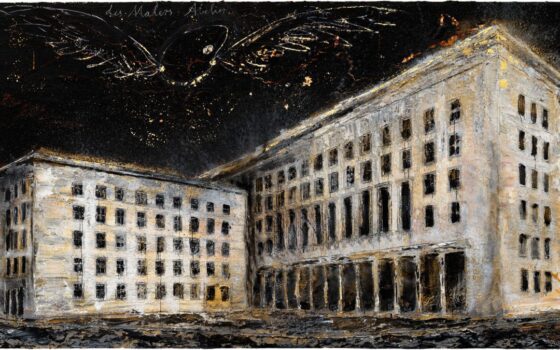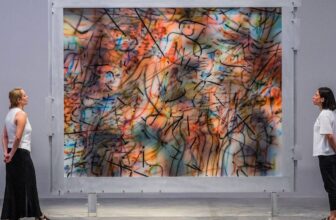What are Famous Paintings by Anselm Kiefer
Anselm Kiefer is one of the most profound and controversial figures in contemporary art. His work is a visceral tapestry of historical memory, mythology, spirituality, and destruction, often rendered in haunting, monumental canvases layered with unusual materials such as lead, straw, ash, clay, and shellac. To step into a room with Kiefer’s paintings is to enter a space where time collapses, where the past bleeds into the present with raw emotional force.
In this story post, we’ll explore the enigmatic world of Anselm Kiefer by delving into his most famous paintings, how he creates his work, the materials and techniques he uses, what he is known for, where his work is located, how much his paintings cost, and how many he has created. This is a journey into one of the most intellectually and emotionally charged oeuvres in modern art history.
Anselm Kiefer: A Post-War Artist Born of Ruins
Born in Donaueschingen, Germany, in 1945, just months before the end of World War II, Anselm Kiefer came of age in the shadows of Nazi destruction and collective German guilt. He was raised in a country still reeling from the devastation of war, where history was taboo and national identity fractured. This cultural void became fertile ground for his artistic inquiry.
Kiefer studied law and Romance languages before eventually turning to art in the late 1960s. He trained under Joseph Beuys at the Kunstakademie Düsseldorf, where he began formulating the aesthetic and thematic directions that would define his work for decades. Beuys, who believed in the healing potential of art, had a deep impact on Kiefer, although the younger artist’s approach would be much darker and more confrontational.
What Is Anselm Kiefer Known For?
Kiefer is known for his large-scale, heavily textured paintings and installations that deal with themes of history, memory, mythology, alchemy, and war, particularly the legacy of Nazi Germany. His work directly challenges the “silence” surrounding German history post-WWII and confronts it with brutal honesty.
He incorporates symbols from Germanic mythology, the Old Testament, Kabbalah, Norse legends, Wagnerian opera, and the poetry of Paul Celan and Ingeborg Bachmann. His works often reflect on the spiritual desolation of the modern world and the cyclical nature of destruction and rebirth.
His use of burnt books, dead plants, straw, rusted metal, ash, and lead speaks not only to the ruins of history but also to the transformative, alchemical process of creation from destruction.
Famous Paintings by Anselm Kiefer
Here are some of Anselm Kiefer’s most celebrated and discussed paintings:
1. “Nigredo” (1984)
This monumental piece (approximately 11 by 18 feet) is named after the first stage in the alchemical process, symbolizing decomposition and blackness. The canvas appears scorched and burned, with a cracked surface evoking a desolate landscape. “Nigredo” exemplifies Kiefer’s interest in both alchemy and spiritual transformation through destruction.
2. “Sulamith” (1983)
This painting commemorates a Jewish woman burned in a Nazi gas chamber and references Paul Celan’s poem “Death Fugue”. It shows a funerary hall inspired by Wilhelm Kreis’s architecture for the Nazis, but transformed into a mausoleum for victims. The work embodies Kiefer’s confrontation with Germany’s dark past.
3. “The Orders of the Night” (1996)
Depicting the artist lying face-down in a field under a cosmic night sky, this painting suggests themes of death, humility before nature, and rebirth through immersion in darkness. It evokes the weight of memory and the insignificance of the self in the face of history and the cosmos.
4. “Seraphim” (1983–84)
In this piece, burnt books hang from wires across the painting’s surface, suggesting not just literal destruction of knowledge but also a spiritual yearning for redemption. The name refers to the angelic beings of fire in the Bible, adding a layer of metaphysical interpretation.
5. “Margarethe” and “Sulamith” (1981)
These two companion pieces respond to Celan’s “Death Fugue” and contrast the Aryan figure of Margarethe with the Jewish Sulamith. While “Margarethe” contains straw (referencing golden hair), “Sulamith” contains charred materials. The contrast illustrates how Kiefer juxtaposes mythology and horror to question complicity and memory.
6. “Breaking of the Vessels” (1990)
A monumental installation referencing the Kabbalistic story of divine light shattering the vessels intended to contain it. It features a massive glass vitrine filled with shattered glass, books, and lead. This piece encapsulates Kiefer’s belief in the ruin as a site of creation, where divine fragments still resonate.
How Does Anselm Kiefer Make His Paintings?
Kiefer’s process is both physical and metaphysical, involving intense labor, ritual, and a nearly sculptural approach to painting. His methods include:
Layering paint with ash, sand, straw, and clay, often applied with palette knives and hands rather than brushes.
Using industrial materials like lead sheets, steel wires, concrete, and oxidized metals.
Burning or charring canvases, allowing chemical reactions to naturally age or distort the surface.
Burying artworks temporarily to allow natural processes (decay, moisture, corrosion) to impact their texture.
Incorporating writing, poetry, and symbolism onto the surface of the canvas, often referencing philosophers, poets, or mystical texts.
His works are not just painted, they are built, burned, broken, and resurrected. Each painting is a ritual of alchemical transformation, embodying both trauma and transcendence.
What Art Style Is Anselm Kiefer Associated With?
Kiefer is most often associated with Neo-Expressionism, but his style is a complex fusion of Conceptual Art, Installation Art, and Symbolist traditions. While rooted in the expressive gestural techniques of post-war painting, his use of symbolic references and sculptural elements sets him apart.
His work also intersects with Arte Povera, a movement that emphasized the use of unconventional, “poor” materials, though Kiefer’s application is far more monumental and historicized. In many ways, Kiefer is a painter-philosopher, using the canvas as a battleground for the psyche, history, and myth.
What Materials Does Anselm Kiefer Use?
Kiefer’s materials are as famous as his themes. He employs:
Lead: Both toxic and historically rich, lead represents Saturn, alchemy, and burden. Kiefer calls it “the only material heavy enough to carry history.”
Straw: Symbolic of Margarethe’s golden hair from Celan’s “Death Fugue”, it also evokes fire, harvest, and decay.
Ash and charcoal: Representing both the literal and symbolic residue of destruction.
Books: Often made from lead, clay, or burned paper. These “sculptural books” suggest lost or forbidden knowledge.
Soil, clay, sand, and stone: Connecting his work to the Earth and burial metaphors.
Gold leaf and resin: Occasionally used to evoke religious or mystical symbolism.
His surfaces are never smooth or purely aesthetic, they are ravaged and pockmarked with time, trauma, and transformation.
How Many Paintings Has Anselm Kiefer Created?
While no exact number is publicly documented, Anselm Kiefer has created hundreds, possibly thousands, of paintings, installations, and sculptural works since the 1960s. His studio practice is prolific, and he maintains multiple large-scale studio spaces, including a 200-acre former silk factory complex in Barjac, France, and a massive warehouse in Croissy-Beaubourg near Paris.
These spaces allow him to work on multiple monumental pieces simultaneously, often stored and revisited over years. Because his works are so layered and process-driven, Kiefer sometimes reworks a canvas decades after starting it.
Where Are Anselm Kiefer’s Paintings Located?
Kiefer’s paintings can be found in major museums and private collections around the world, including:
Tate Modern (London) – Home to several of his iconic paintings and installations.
The Museum of Modern Art (MoMA), New York – Holds important early works.
Guggenheim Museum (Bilbao and New York) – Hosts permanent and traveling exhibitions.
The Louvre, Paris – In 2007, he became the first living artist to exhibit at the Louvre since Georges Braque.
Centre Pompidou (Paris) – Holds a significant Kiefer collection.
San Francisco Museum of Modern Art
The Broad (Los Angeles)
Art Institute of Chicago
Neue Nationalgalerie (Berlin) – Holds works especially relevant to his German identity.
Many of his most monumental works are displayed in temporary exhibitions due to their scale, weight, and materials. His personal studio spaces (especially in Barjac) function almost as museums themselves, occasionally opened for curated visits or film documentation.
How Much Do Anselm Kiefer’s Paintings Cost?
Anselm Kiefer’s artworks command millions of dollars on the international market. Prices vary depending on size, date, and provenance:
Smaller works or works on paper can range from $100,000 to $500,000.
Mid-size mixed media works typically fetch $1 million to $3 million.
Monumental works or historically significant paintings can exceed $5 million.
His most expensive works have been sold at auction for $6 million to $8 million or more.
Collectors of Kiefer’s work include institutions, private collectors, and luxury patrons interested not just in aesthetics but in intellectual and historical weight.
Anselm Kiefer Legacy and Impact
Anselm Kiefer’s art is not beautiful in a conventional sense. It’s stark, heavy, painful, and yet, deeply sublime. He has changed the trajectory of post-war art by forcing his viewers to confront the cultural amnesia and moral ambiguities of modern history.
Where others turned away from the ruins, Kiefer painted them, again and again, until they spoke. His canvases are not just artworks, but testimonies. They ask us: What do we remember? What do we bury? And what rises from the ashes?
To understand Anselm Kiefer is to engage with the deepest questions of history, myth, identity, and art’s role in truth-telling. His paintings are physical and philosophical monuments to loss and transformation, memory and mythology, and decay and rebirth.
From scorched fields and leaden books to angelic wings and Kabbalistic mysticism, Kiefer invites us to wander through a wounded cosmos, where art doesn’t heal, but keeps the wound open, so that we never forget. image/ Georges Poncet




